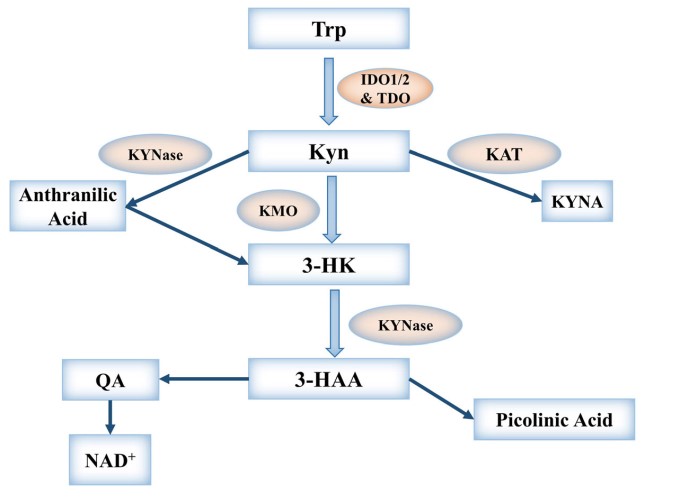Hi-Affi™ hPD-1/hPD-L1/hIDO1 Triple Humanized Mouse Model
Indoleamine 2,3-dioxygenase (IDO1), a rate-limiting enzyme, has been taken as a potential drug target for cancer treatment. Considering the limitations of monotherapy, the combination of IDO1 inhibitors with anti-hPD-1 and anti-hPD-L1 antibodies has been proposed. Creative Biolabs has successfully established an optimized Hi-Affi™ “humanized” animal platform to offer specialty manipulated hPD-1/hPD-L1/hIDO1 triple humanized mice for our clients all over the world.
hPD-1/hPD-L1/hIDO1 Molecule
Human programmed cell death-ligand 1 (hPD-L1) and its receptor human programmed cell death protein 1 (hPD-1) are co-inhibitory molecules present on the surface of tumor and immune cells, respectively. The ligation of hPD-1 and hPD-L1 transmits a down-regulatory signal for immune response.
IDO1 is the only rate-limiting enzyme outside the liver. It catalyzes the metabolism of tryptophan, causing tryptophan to decompose along the kynurenine pathway to a series of metabolites including quinolinic acid. Under normal circumstances, its expression level is strictly controlled, but can be induced in tumor-infiltrating tissues. And the great increase of IDO1 in tumor-draining lymph nodes is closely related to tumor immune tolerance.
hPD-1/hPD-L1/hIDO1 Signal Pathway
The hPD-L1 and hPD-1 are both co-inhibitory proteins that negatively regulate the activity of T lymphocytes. Their ligation can regulate the intensity and breadth of the immune response, thereby preventing damage and destruction of normal tissues. Unfortunately, tumor cells utilize this mechanism to escape the immune attack. In tumor tissues, tumor cells can also utilize the function of human IDO1 (hIDO1) to suppress the body's immune response. hIDO1 mediates the immunosuppressive function in vivo mainly through three mechanisms including general control nonderepressible 2 (GCN2), mTOR, and aromatic hydrocarbon receptor (AhR). Firstly, hIDO1 degrades L-Trp and deplete L-Trp in the local tissue microenvironment, resulting in the free state of tRNA transporting L-Trp. The GCN2 contains an allosteric regulatory site to be activated. The activated GCN2 kinase phosphorylates downstream eukaryotic translation initiation factor-2α (eIF-2α), resulting in weakened transcriptional function of eIF-2α, thereby inhibiting the transcription of various RNAs and protein translation processes in T cells. Secondly, the lack of L-Trp can inhibit the master amino acid-sensing kinase 1 (GLK1), which in turn inhibits the mTOR signaling, triggering T cellular immune incompetence and autophagy. The third mechanism is L-Trp metabolite kynurenine (KYN) mediated. KYN produced by the metabolism of L-Trp by hIDO1 is an endogenous ligand of AhR. KYN binding to AhR leads to immature CD4+ T cells differentiation into inhibitory T Cells. Besides, KYN combining with AhR can also induce hIDO1 expression, further suppressing the immune response of T cells. The hIDO1 also has a certain effect on tumor cell angiogenesis. Studies have shown that hIDO1 can increase the expression of IL-6 in tissues through the consumption of tryptophan in the tryptophan metabolism pathway, thereby increasing the expression of VEGF and promoting tumor angiogenesis.
 Fig.1 The IDO metabolic pathway. (Liu, 2018)1, 2
Fig.1 The IDO metabolic pathway. (Liu, 2018)1, 2
Development of hPD-1/hPD-L1/hIDO1 Triple Humanized Mice
Although hIDO1 is one of the body's important immune checkpoints, it is not the only one. In other words, tumor cells can achieve immune escape through multiple pathways. Therefore, the use of hIDO1 inhibitors alone to treat tumors often has limited effects. In the contrast, the combination of hIDO inhibitors and other immune checkpoint inhibitors, such as anti-hPD-1 and anti-hPD-L1 antibodies will be a trend in drug development. Creative Biolabs has advanced lots of drug development projects for our global clients using Hi-Affi™ “humanized” animal models. We have accumulated much experience in preclinical drug development and can provide related research services. Please feel free to contact us if you have any questions.
Creative Biolabs also offers other various Humanized Mouse Models you may be interested in:
References
- Liu, M.; et al. Targeting the IDO1 pathway in cancer: from bench to bedside. J Hematol Oncol. 2018, 11(1): 100.
- under Open Access license CC BY 4.0, without modification.
For Research Use Only.
